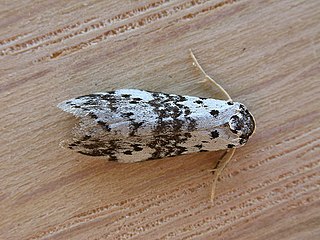Related Research Articles

Halone coryphoea is a moth of the subfamily Arctiinae first described by George Hampson in 1914. It is found in Australia.

Halone sejuncta, the variable halone, is a moth of the subfamily Arctiinae first described by Rudolf Felder and Alois Friedrich Rogenhofer in 1875. It is found in Australia in Queensland, New South Wales, the Australian Capital Territory, Victoria, Tasmania and South Australia.

Thallarcha is a genus of moths in the subfamily Arctiinae.

The Depressariinae – sometimes spelled "Depressiinae" in error – are a subfamily of moths in the superfamily Gelechioidea. Like their relatives therein, their exact relationships are not yet very well resolved. It has been considered part of family Elachistidae sensu lato or included in an expanded Oecophoridae. In modern classifications they are treated as the distinct gelechioid family Depressariidae.

The Alex Halone House in Thermopolis, Wyoming, was built by Finnish immigrant Alex Halone for his personal residence in 1909–1910. Halone, a stonemason, built several stone structures in Thermopolis. Three generations of the Halone family were stonemasons. The grounds include a log Finnish sauna built by Alex and Eugene Halone with assistance from Lauri Suikaonen in 1946-51.

Halone pteridaula, the brown halone, is a species of moth of the subfamily Arctiinae first described by Turner in 1922. It is known from the Australian Capital Territory, New South Wales, Queensland, Tasmania and Victoria, all in Australia.

Halone prosenes, the pied halone, is a moth of the subfamily Arctiinae first described by Turner in 1940. It is known from the Australian state of Victoria, where it is restricted to the South East Coastal Plain, South Eastern Highlands and the Victorian Volcanic Plain.

Xyloryctidae is a family of moths contained within the superfamily Gelechioidea described by Edward Meyrick in 1890. Most genera are found in the Indo-Australian region. While many of these moths are tiny, some members of the family grow to a wingspan of up to 66 mm, making them giants among the micromoths.
Halone consolatrix is a moth of the subfamily Arctiinae. It was described by Rudolph Rosenstock in 1899. It is found in Australia.
Halone ebaea is a moth of the subfamily Arctiinae. It was described by George Hampson in 1914. It is found in Australia.
Halone interspersa is a moth of the subfamily Arctiinae. It was described by Thomas Pennington Lucas in 1890. It is found in Australia.
Halone ophiodes, the cryptic halone, is a moth of the subfamily Arctiinae. It was described by Edward Meyrick in 1886. It is found in Australia.
Halone servilis is a moth of the subfamily Arctiinae. It was described by Edward Meyrick in 1886. It is found in Australia.
Halone sinuata, the rock lichen moth, is a moth of the subfamily Arctiinae. It was described by Wallengren in 1860. It is found in Australia.
Halone sobria is a moth of the subfamily Arctiinae. It was described by Francis Walker in 1854. It is found in Australia.
Halone flavescens is a moth of the subfamily Arctiinae. It was described by George Hampson in 1898. It is known from Assam, India.
Halone flavinigra is a moth of the subfamily Arctiinae. It was described by George Hampson in 1907. It is known from India.
Halone diffusifascia is a moth of the subfamily Arctiinae. It was described by Swinhoe in 1896. It is known from Assam, India.
H. flavescens may refer to:
References
- ↑ Savela, Markku (December 7, 2015). "Halone epiopsis Turner, 1940". Lepidoptera and Some Other Life Forms. Retrieved October 18, 2019.
- Pitkin, Brian & Jenkins, Paul. "Search results Family: Arctiidae". Butterflies and Moths of the World. Natural History Museum, London.
| This Lithosiini-related article is a stub. You can help Wikipedia by expanding it. |